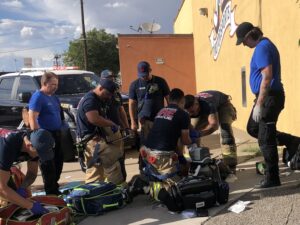11:18
News Story
The pandemic put Missouri mothers at greater violence risk — especially if they were Black
Social isolation during the pandemic put Missouri’s Black moms in greater danger that their partner would kill them.
A report from the state’s maternal mortality review board found that from 2018 to 2020, homicide was the third-leading cause of death for Missouri moms. Black women made up 75% of those deaths. Among those homicides, guns were the sole means of death and all of them occurred in Missouri’s urban areas.
Isolation during the pandemic “was basically the perfect storm,” said Dr. Traci Johnson, an obstetrician at University Health and the chair-elect of the state’s maternal mortality review board.
Across those years, an average of 70 women died in the year after they gave birth, peaking in 2020 at 85. That average is up from 61 deaths a year from 2017 to 2019, the last time Missouri analyzed its maternal mortality rate.
In each of the years covered by the report, an average of six Black women were shot by current or former partners. Half those homicides came when the mother had previously suffered domestic violence.
Mental health conditions mark the leading cause of maternal deaths, rising to an average of 25 a year. Early reports showed an average of 17.
MaryAnne Metheny, the CEO of the Kansas City domestic violence shelter Hope House, said the pandemic brought more intense cases of abuse. She also said people trying to impose control on their partners can become more violent when an infant arrives.
“The first year after pregnancy can be a very dangerous time for domestic violence victims,” she said. “During the height of COVID, what we saw in general was that the model or intensity of abuse skyrocketed.”
FBI statistics show Missouri’s aggravated assault rate in 2020 ran far above the nationwide average. It grew from about 360 aggravated assaults per 100,000 people in 2019 to 413 in 2020. Across the United States, that figure jumped significantly less, to about 280 assaults per 100,000 people from 250 in 2018.
Responses to the pandemic exposed holes in the health care system and gave women less access to their doctors and support systems. That made it more difficult for health care providers to have candid conversations about what patients experienced at home.
“You couldn’t get to the physician or the clinician to tell us in a safe way,” Johnson said, “because your visits are telehealth and you might be in the room with the person who’s harming you or threatening you.”
Without confidential visits with doctors, experts say women are less likely to report the violence they face in their homes.
“They may not want to go public with what may be going on at home,” said Tracy Russell, the executive director of Nurture KC. “And so you have to have those trusted relationships.”
Russell also emphasized the importance of mental health support for new fathers in much the way health care providers and community organizers are making strides to support the mental health of new moms.
“It’s time that we invest in that and recognize the responsibility of partners in the family,” she said, “and the importance of partners in the family.”
Plus, Russell said, Missouri’s abortion ban will mean more unwanted pregnancies.
“We’ve not given enough credence to the complexity of that issue,” she said, “and the dynamics that are created as a result of carrying an unwanted pregnancy.”
The role of firearms in domestic violence situations
One study of 11 major cities found the presence of a gun in a home with domestic violence increased the chance of homicide by 500%.
Major cities in Missouri, like Kansas City, St. Louis and Springfield, have looked for ways to pass gun safety measures to make their communities safer and reduce homicide rates. But Missouri state law does not allow municipalities to pass their own legislation on the issue.
Russell said cities should be able to pass ordinances addressing gun violence and the needs of their own communities.
“We couldn’t have this conversation if we didn’t talk about unfettered access to guns,” Russell said. “There has to be the means for this to occur, and the inability of the city to be able to adopt its own ordinances, according to community needs, is a problem.”
A February 2023 poll from St. Louis University found that 69% of Missourians favored mental health background checks before someone can purchase a gun. Another 60% favor red flag laws that would allow courts to temporarily remove guns from people deemed unsafe, while 25% oppose them.
In Kansas, people convicted of domestic violence are prohibited from possessing firearms if they have been convicted within the preceding five years.
St. Louis has one of the highest homicide rates in the nation. St. Louis Mayor Tishaura Jones wants to ban anyone 18 or younger from buying bullets without parental consent, and she wants to ban devices that can turn semiautomatic handguns into automatic weapons capable of firing a burst of bullets with a single pull of the trigger.
Gov. Mike Parson told cities to “stay in your lanes” on gun control.
“Cities can’t just go out there and do what they want to do, and when there is a constitutional issue to it, or state legislature to it, they can’t supersede that,” Parson said last week in response to Jones’ proposals. “…You’ve got to obey the law, is the way I look at it, and there are no exceptions.”
Attorney General Andrew Bailey also wrote a letter to Jones saying the state would “resist any effort to infringe on the right of the people of Missouri to keep and bear arms.”
Housing a top challenge for domestic violence victims
A lack of somewhere else to live can make it harder for mothers to leave unsafe situations. A report from Rutgers University found that the way the coronavirus amplified poverty made it more difficult for women experiencing domestic violence to find a place to live.
“It can take someone an average of seven times to leave before they’re able to leave for good,” Metheny said. “And often that is because of the obstacles that are in their way.”
It’s a situation where providers and community health organizations see room for policy interventions.
“It’s a policy change, looking at funding and redistribution of funding to places that support pregnant women,” Johnson said. “It’s a choice when the government decides where to put those funds.”
Johnson said taxpayers might be able to protect mothers better by giving them services like transportation, access to safe neighborhoods and quality medical treatment.
“They’re all based on policy decisions,” she said. “If we put funding in that area, then it will make the system less strained for vulnerable patients.”
This article first appeared on The Beacon and is republished here under a Creative Commons license.
Our stories may be republished online or in print under Creative Commons license CC BY-NC-ND 4.0. We ask that you edit only for style or to shorten, provide proper attribution and link to our website. AP and Getty images may not be republished. Please see our republishing guidelines for use of any other photos and graphics.





